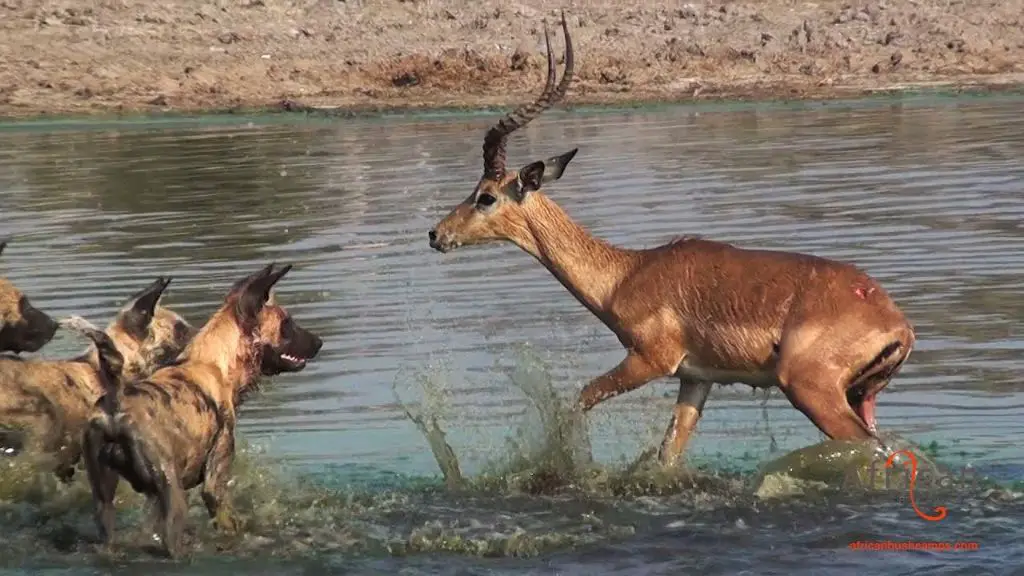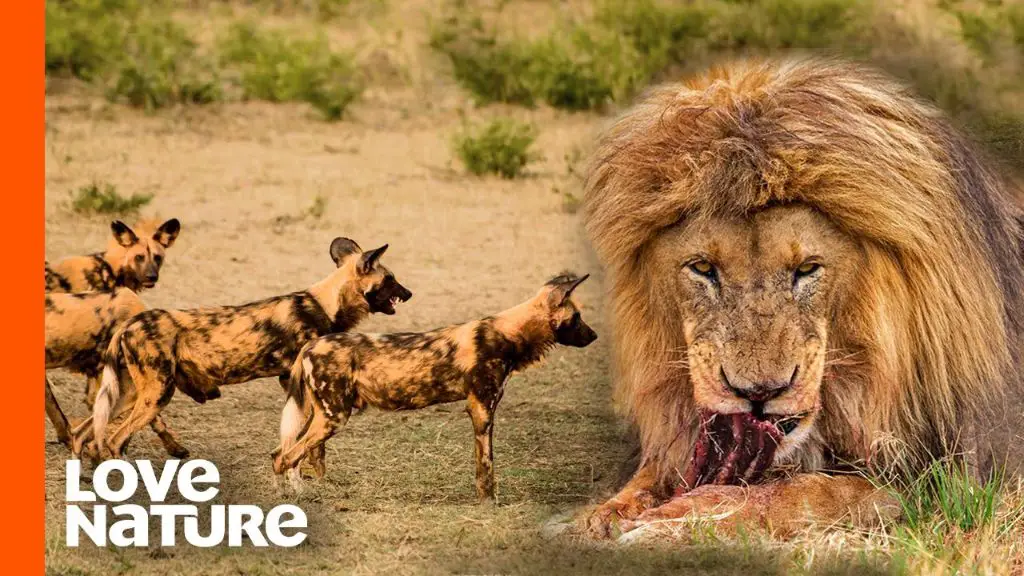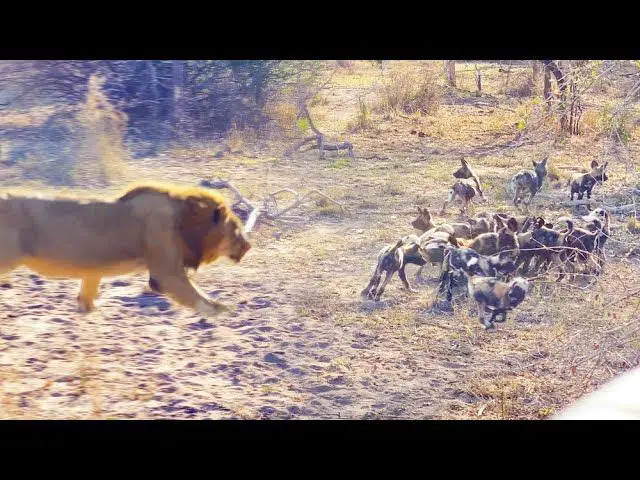Introduction
Lions and African wild dogs are iconic apex predators that occupy similar ecological niches across sub-Saharan Africa. Both species hunt cooperatively in packs and rely on similar prey items like antelope and zebra, bringing them into direct competition for resources. Though direct attacks are uncommon, lions view wild dogs as a threat and will kill wild dog pups and adults on occasion. The two species must carefully navigate sharing territory and prey sources, an increasing challenge as both face conservation threats and declining populations.
This article examines the complex relationship between lions and wild dogs in the wild. It provides an overview of how these two formidable predators manage to coexist, including factors like wild dog pack defense strategies, indirect aggression between the species, and vulnerable pup interactions. As human activity encroaches on wildlife habitats, a nuanced understanding of lion and wild dog interactions can support ongoing conservation efforts and promote the coexistence of these iconic species.
Lions as Top Predators
Lions are apex predators, meaning they are at the top of the food chain and have no natural predators in the wild (National Zoo). As carnivores, lions primarily hunt and eat large prey like zebra, wildebeest, and buffalo (Lion Alert). Lions are opportunistic hunters and will prey upon a wide variety of animals based on availability, from rodents and reptiles up to giraffe and hippos. However, medium-sized ungulates like impala and warthog make up the bulk of their diet (National Zoo).
Lions are formidable hunters, using stealth and teamwork to stalk and ambush their prey. They rely on their keen senses of sight, hearing and smell to detect prey animals. Once in proximity, lions launch explosive attacks relying on their strength, speed and deadly claws and teeth to take down and kill their quarry (Lion Alert). Male lions do the majority of the hunting, though lionesses also contribute and are the primary hunters in some prides. After making a kill, the males typically eat first, followed by high-ranking females and finally the cubs.
Wild Dogs as Effective Hunters

Wild dogs are skilled pack hunters that use highly coordinated teamwork to pursue and bring down prey. According to the Queensland Department of Agriculture and Fisheries, wild dogs employ a variety of hunting strategies including searching, stalking, ambushing, racing and pouncing [1]. Packs will fan out and encircle prey before attacking, relying on their endurance, intelligence and numbers to tire out intended targets.
Wild dogs prey on a diverse range of species across their habitat range. Medium-sized hoofed animals like impala, bushbuck and wildebeest form a major part of their diet in Africa [2]. In Australia, kangaroos, wallabies and rabbits are frequent targets. They will also hunt small mammals, reptiles, birds, fish, invertebrates and even eat fruit and vegetation [1].
Competition Between Species
Lions and African wild dogs occupy similar ecological niches as large carnivores, resulting in competition for resources like prey animals. Research has shown that lions perceive wild dogs as competitors and a threat to their dominance (Creel, 1996).
Both lions and wild dogs rely on medium to large prey species like wildebeest, zebra, and impala for food. However, wild dogs are very efficient hunters, with hunt success rates of 60-90% compared to lions at 10-40% (PBS LearningMedia). This hunting prowess allows wild dog packs to take down prey more consistently, leaving fewer animals available for lions.
Lions recognize wild dogs as a challenge to their ability to monopolize food resources. Studies have found a strong negative correlation between lion and wild dog population densities, indicating they struggle to coexist (Creel, 1996 https://www.jstor.org/stable/2386867). Lions will go to great lengths to kill wild dogs and eliminate the competition.
Direct Attacks are Rare
Even though lions and wild dogs compete for the same prey and habitat, direct attacks by lions on wild dogs are quite rare. Lions are much larger and physically dominant over wild dogs, but wild dogs’ effective cooperative hunting enables them to hold their own against lions in most interactions. According to a report, observations across Africa indicate that lions directly prey on wild dogs infrequently.
There are a few reasons why direct attacks by lions on wild dogs are uncommon. Wild dogs are swift and agile hunters that work together in packs, making them difficult targets for lions to catch and subdue. Wild dogs also utilize versatile hunting techniques, allowing them to adapt and find prey even in areas dominated by lions. Additionally, wild dogs are not in direct competition for the larger prey that lions target.
While hostile encounters do occur, especially when defending kills or territory, lions do not routinely hunt and kill wild dogs. Direct attacks by lions account for only a small percentage of wild dog mortalities across their range. Overall, the two species mostly avoid each other and rarely engage in outright battles. The threat to wild dogs instead often comes from indirect competition with lions for limited prey and habitat.
Indirect Aggression More Common
Though direct attacks are rare, lions more commonly display indirect aggression towards wild dogs. Lions will often steal fresh kills from wild dog packs. This freeloading behavior allows lions to conserve energy while still gaining the nutritional benefits from a fresh kill. According to this footage, a pride of lions ambushed and aggressively stole an impala kill from a pack of wild dogs. The wild dogs scattered and could only watch from a distance as the lions took over their hard-earned meal.

This type of indirect aggression and kleptoparasitism (stealing of prey) by lions can significantly impact wild dog populations. By stealing their kills, lions not only reduce the amount of food available to wild dog packs, but also force the wild dogs to expend extra energy on additional hunts. This creates greater nutritional stress and deprivation that can be especially detrimental to juvenile and pregnant wild dogs with high caloric needs.
Vulnerable Wild Dog Pups
Wild dog pups are especially vulnerable to predation from lions. Lion predation is considered the primary threat to wild dog pup survival according to some studies. One analysis in the Kruger National Park found that within the first year of life, more than 60% of wild dog deaths were caused by lions.

Young pups are left in the den by the pack while adults go out hunting, making them easy targets for lions and other predators. The pups cannot adequately defend themselves at this stage. Even older pups that start joining adults on hunts can fall prey to lions. The wild dogs may try to defend the pups but adult lions are larger and more powerful.
Some evidence indicates that up to 70% of wild dog pups may perish due to lions. Conservationists are concerned since wild dog populations are already endangered. While the relationship between the two species is complex, lion predation on vulnerable wild dog young remains a major threat to the wild dogs’ breeding success and future survival.
Conservation Concerns
African wild dog populations have declined significantly, with only about 6,600 individuals left in the wild according to the IUCN Red List https://www.worldwildlife.org/species/african-wild-dog. They face threats from habitat loss and fragmentation, disease, human persecution, and competition from other predators like lions.
Lions pose a major threat to wild dogs through both direct attacks and by stealing their kills. Lions will aggressively chase wild dogs from prey and take over their kills, robbing the wild dog packs of food https://globalconservation.org/species-facing-extinction/african-wild-dog/. Lions have also been documented killing wild dog pups and adults in their dens. The predation pressure from lions makes it difficult for wild dog populations to recover in areas with high lion densities.
Conservationists recommend maintaining buffer zones between wild dog and lion territories and protecting den sites to give vulnerable wild dog pups a chance of survival. Reducing competition over prey through conservation efforts that maintain healthy prey populations can also help mitigate risky interactions between the two species.
Managing Coexistence
Even though direct attacks between lions and wild dogs are rare, the two species still compete for resources and habitat. This leads to issues of coexistence that conservationists aim to manage. Strategies to enable lion and wild dog survival focus on understanding how the species interact and partitioning available habitat and prey.
Research shows that spatial separation is a key factor facilitating coexistence between lions and wild dogs (Davies, 2021). Wild dogs tend to avoid areas frequented by lions, selecting habitats based on where lion activity is lower. Conservation efforts can take advantage of this by establishing protected areas and corridors that provide adequate space for separation between the species.

Studies also find that an abundance and diversity of prey helps reduce competition and supports populations of both lions and wild dogs in the same area. Sufficient prey densities allow lions to fulfill their needs without heavily impacting wild dog hunts and food intake. Managing protected areas to maintain robust prey populations and multiple habitat types can enable coexistence (Davies, 2021).
Ultimately, a mosaic landscape with areas of high and low lion densities, connected by dispersal corridors, allows wild dogs to find suitable habitat while minimizing risky encounters. This highlights the importance of large protected areas and wildlife-friendly land management for the conservation of lions, wild dogs, and other African carnivores.
Conclusion
The relationship between lions and wild dogs is complex. As apex predators, lions and wild dogs occupy a similar ecological niche and thus compete for resources. However, direct predation of one species upon the other is quite rare. Lions will seldom go after adult wild dogs due to the risk of injury from a pack defending itself. For their part, wild dogs avoid adult lions. However, both species will opportunistically kill the other’s vulnerable young. The main interaction is indirect aggression and displacement from kills. Lions will often appropriate fresh wild dog kills, forcing the pack to expend more energy on hunting. Wild dogs may be excluded from prime habitat and feeding grounds due to the presence of lion prides. With decreasing natural habitat, such competition can negatively impact wild dog populations already under threat. Conservation efforts aim to preserve sufficient protected areas and connectivity for both wide-ranging species to fulfill their ecological roles with minimal conflict. Though competitors, sustainable populations of lions and wild dogs enrich their shared ecosystems.